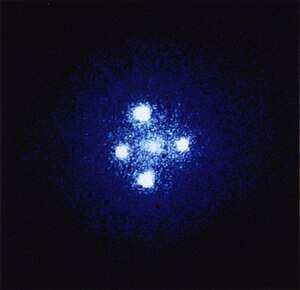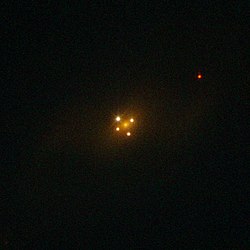Einsteinův kříž
| QSO 2237+0305 | |
|---|---|
 Einsteinův kříž | |
| Pozorovací údaje (Ekvinokcium J2000) | |
| Typ | LeQ |
| Rektascenze | 22h 40m 30,3s |
| Deklinace | +3° 21′ 31″ |
| Souhvězdí | Pegas (lat. Pegasus) |
| Zdánlivá magnituda (V) | 16,78 |
| Úhlová velikost | méně než 2" |
| Vzdálenost | 2 500 000 000 pc (8 000 000 000 ly) |
| Rudý posuv | 1,695 |
| Označení v katalozích | |
| Principal Galaxies Catalogue | PGC 69457 |
| Jiná označení | LEDA 69457, Z 378-15 |
| (V) – měření provedena ve viditelném světle | |
| Některá data mohou pocházet z datové položky. | |
Einsteinův kříž (Q2237+030 nebo QSO 2237+0305) je kvasar v souhvězdí Pegase, jehož zdánlivá podoba je výsledkem gravitačního čočkování galaxie ZW 2237+030, která je označována jako Huchrova čočka. Výsledkem tohoto jevu jsou čtyři zesílené obrazy kvasaru rozmístěné ve tvaru kříže kolem centra, v němž se nachází čočkující galaxie.[1][2]
Zdroje světla, které jsou ohýbány gravitačními čočkami galaxií, většinou vytváří Einsteinův kruh. Čočkující galaxie ZW 2237+030 má ale podlouhlý tvar a kvasar Q2237+030 se nenachází ve středu, takže společně vytváří specifický kříž.[3]
Popis

Einsteinův kříž je umístěn v souhvězdí Pegase na 22h 40m 30,3s, +3° 21′ 31″.
Rudý posuv kvasaru naznačuje, že se nachází osm miliard světelných let od Země, zatímco čočkující galaxie je ve vzdálenosti 400 milionů světelných let. Její zdánlivá velikost je 0,87 × 0,34 úhlové minuty,[4] zdánlivá velikost kříže činí 1,6 × 1,6 úhlové vteřiny.
K pozorování Einsteinova kříže se zdánlivou magnitudou 16,78 je potřeba velmi temná obloha a dalekohled s průměrem zrcadla minimálně 46 cm.[5]
Jednotlivé obrazy kvasaru jsou značeny písmeny A až D (např. QSO 2237+0305 A). Čočkující galaxie je někdy označována jako QSO 2237+0305 G.
Reference
V tomto článku byl použit překlad textu z článku Einstein Cross na anglické Wikipedii.
- ↑ NASA AND ESA. The Gravitational Lens G2237 + 0305 [online]. September 13, 1990 [cit. 2006-07-25]. Dostupné online. (anglicky)
- ↑ DRAKEFORD, Jason; CORUM, Jonathan; OVERBYE, Dennis. Einstein’s Telescope - video (02:32). New York Times. March 5, 2015. Dostupné online [cit. December 27, 2015]. (anglicky)
- ↑ How does gravitational lensing account for Einstein's Cross? [online]. [cit. 2016-06-26]. Dostupné online. (anglicky)
- ↑ LEDA 69457 [online]. [cit. 2017-02-12]. Dostupné online. (anglicky)
- ↑ CRINKLAW, Greg. Focus on Einstein's Cross [online]. [cit. 2013-06-29]. Dostupné online. (anglicky)
Externí odkazy
 Obrázky, zvuky či videa k tématu Einsteinův kříž na Wikimedia Commons
Obrázky, zvuky či videa k tématu Einsteinův kříž na Wikimedia Commons
Média použitá na této stránce
Autor: ESA/Hubble & NASA, Licence: CC BY 3.0
This NASA/ESA Hubble Space Telescope picture may trick you into thinking that the galaxy in it — known as UZC J224030.2+032131 — has not one but five different nuclei. In fact, the core of the galaxy is only the faint and diffuse object seen at the centre of the cross-like structure formed by the other four dots, which are images of a distant quasar located in the background of the galaxy.
The picture shows a famous cosmic mirage known as the Einstein Cross, and is a direct visual confirmation of the theory of general relativity. It is one of the best examples of the phenomenon of gravitational lensing — the bending of light by gravity as predicted by Einstein in the early 20th century. In this case, the galaxy’s powerful gravity acts as a lens that bends and amplifies the light from the quasar behind it, producing four images of the distant object.
The quasar, being 11 billion light-years from us in the direction of the constellation of Pegasus, is seen as it was around 11 billion years ago. The galaxy that works as a lens is some ten times closer. The alignment between the two objects is remarkable (within 0.05 arcseconds), which is in part why such a special type of gravitational lensing is observed.
This image is likely the sharpest image of the Einstein Cross ever made, and was produced by Hubble’s Wide Field and Planetary Camera 2, and has a field of view of 26 by 26 arcseconds.تقاطع أينشتاين: أربع صور لنفس النجم الزائف البعيد (وذلك بفعل عدسة الجاذبية الناتجة عن المجرة الأقرب لنا، والظاهرة في المقدمة، وهي مجرة عدسة هاكرا).

